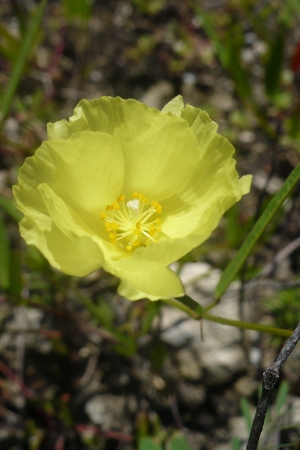Plants of South Florida · Plants by Conservation Area · Plants by County · Plants by Habitat Quick Search · Advanced Search |
||
|
|
||
 |
Cienfuegosia yucatanensis Millsp. Yucatan%20flymallow |
|
|
South Florida Status: Critically imperiled. Three occurrences in three conservation areas and two non-conservation areas (Klopp Tract, Lignumvitae Key Botanical State Park; Long Key State Park, Long Key Layton Coastal Rock Barren, & North Layton Hammock; Windley Key Fossil Reef Geological State Park). Taxonomy: Dicotyledon; Malvaceae. Habit: Perennial terrestrial herb. Distribution: Native to South Florida, the West Indies, and Mexico in the Yucatan. South Florida Distribution: Monroe County Keys. South Florida Habitats: Coastal rock barrens, margins of tidal swamps, and edges of rockland hammocks. Protection Status: Listed as endangered by FDACS and as critically imperiled by FNAI. Aids to Identification: Scurlock (1987) has color photos; Chafin (2000) has illustrations and a color photo; the IRC Website has a color photo. References: Small, 1933a; Fryxell, 1969; Scurlock, 1987; Nelson, 1996; Wunderlin, 1998; Chafin, 2000; Coile, 2000. Synonyms: C. heterophylla (Vent.) Garcke, misapplied. Historical Context: John Loomis Blodgett first collected Yucatan flymallow between 1838 and 1853 on Lignumvitae Key (s.n., NY). It was subsequently reported or collected from Windley Key, where it needs to be vouchered, south to Key West (Chapman s.n., US). It is extirpated on Key West, Grassy Key (Curtiss 398, US), and Lignumvitae Key. In 1892, Joseph H. Simpson made a collection on Long Key (469, GH, NY, US), where it was vouchered again in 1964 by Olga Lakela (27938, FLAS, USF). George N. Avery observed it there in 1966, noting that there were “large stands of this here” (Avery’s Notes, 19 April 1966). It is extant on that island at three stations. The first is at Long Key State Park, where Avery vouchered it in 1971 (1084, FTG). Gann, Bradley and Florida Park Service biologist Janice A. Duquesnel observed plants there as recently as 2000. A few hundred plants were estimated to be present. It also has been observed in both Long Key Layton Coastal Rock Barren and North Layton Hammock, two privately owned parcels that are adjacent to each other on Long Key. Bradley and Wayne Hoffman observed plants there in 1998. Close to 1,000 plants were estimated to be present. This is the largest extant colony of Yucatan flymallow. John Kunkel Small made a collection on Lower Matecumbe Key in 1917 (8392, FSU, NY), a station that was vouchered again by several collectors: Small and others in 1925 (11599, FLAS, FSU, GH, NY); Walter M. Buswell in 1933 (s.n., ARIZ); and George N. Avery in 1965 (s.n., FLAS, GH). Gann and Duquesnel rediscovered it on that island at the Klopp Tract, Lignumvitae Key Botanical State Park in 2000. Fewer than 100 plants were observed. This station needs to be vouchered. Development of the Klopp Tract as a support facility for Lignumvitae Key Botanical State Park threatens this population of Yucatan flymallow. Yucatan flymallow also has been observed at Windley Key Fossil Reef Geological State Park, where it needs to be vouchered. Karen Achor first reported it there in 1982 (in Weiner 1980, as appended). J. Paul Scurlock reported plants there in 1987, as did Curtis R. Kruer in 1992. Gann, Duquesnel, and Bradley observed plants there as recently as 1999. Fewer than 100 plants were seen in and around a small coastal rock barren. Major Threats: Habitat destruction at the Long Key Layton Rock Barren site, North Layton Hammock, and Klopp Tract, Lignumvitae Key Botanical State Park; exotic pest plant invasions; sea-level rise. Comments: The population at Windley Key is found in and around an extremely small coastal rock barren and some research to determine management options for this unique and critically important site are encouraged. Recommendations: • Voucher plants at Klopp Tract, Lignumvitae Key Botanical State Park and Windley Key Fossil Reef Geological State Park. • Map and monitor known stations on a regular basis. • Acquire Long Key Layton Coastal Rock Barren and North Layton Hammock sites. • Study management options at Windley Key Fossil Reef Geological State Park. • Ensure that development of facilities at Klopp Tract does not harm Yucatan flymallow. • Consider reintroducing Yucatan flymallow to other sites within its historical range, including Lignumvitae Key Botanical State Park. • Consider introducing Yucatan flymallow to other sites within its historical range, including Little Hamaca Park. |
||



